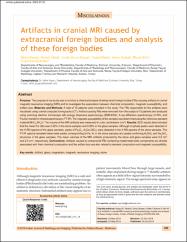| dc.contributor.author | Kayacı, Selim | |
| dc.contributor.author | Tabak, Ahmet | |
| dc.contributor.author | Durur-Subaşı, Irmak | |
| dc.contributor.author | Eldeş, Tuğba | |
| dc.contributor.author | Köksal, Vaner | |
| dc.contributor.author | Şirin, Murat | |
| dc.contributor.author | Arslan, Yusuf Kemal | |
| dc.date.accessioned | 2020-12-19T19:36:52Z | |
| dc.date.available | 2020-12-19T19:36:52Z | |
| dc.date.issued | 2019 | |
| dc.identifier.citation | Kayaci, S., Tabak, A., Durur-Subasi, I., Eldes, T., Koksal, V., Sirin, M., & Arslan, Y. K. (2019). Artifacts in cranial MRI caused by extracranial foreign bodies and analysis of these foreign bodies. The Indian journal of radiology & imaging, 29(3), 299–304. https://doi.org/10.4103/ijri.IJRI_211_18 | en_US |
| dc.identifier.issn | 0971-3026 | |
| dc.identifier.issn | 1998-3808 | |
| dc.identifier.uri | https://doi.org/10.4103/ijri.IJRI_211_18 | |
| dc.identifier.uri | https://hdl.handle.net/11436/1487 | |
| dc.description | Subasi, Irmak Durur/0000-0003-3122-4499; ARSLAN, YUSUF KEMAL/0000-0003-1308-8569; Sirin, Murat/0000-0001-6864-752X | en_US |
| dc.description | WOS: 000502070700011 | en_US |
| dc.description | PubMed: 31741599 | en_US |
| dc.description.abstract | Purpose: the purpose of our study was to conduct a chemical analysis of extracranial foreign bodies (FBs) causing artifacts in cranial magnetic resonance imaging (MRI) and to investigate the association between chemical composition, magnetic susceptibility, and artifact size. Materials and Methods: A total of 12 patients were included in the study. the FBs responsible for the artifacts were visualized using cranial computed tomography (CT). Artifact-causing FBs were removed from the scalps of 10 patients and analyzed using scanning electron microscope with energy dispersive spectroscopy (SEM-EDS), X-ray diffraction spectroscopy (X-RD), and Fourier-transform infrared spectroscopy (FT-IR). the magnetic susceptibility of the samples was determined using the reference standard material MnCl2.6H(2)O. the volume of the MRI artifacts was measured in cubic centimeters (cm(3)). Results: EDS results demonstrated that the mean Fe ratio was 5.82% in the stone samples and 0.08% in the glass samples. Although no phase peaks were detected in the X-RD spectra of the glass samples, peaks of Fe2O3, Al2Ca (SiO4) were detected in the X-RD spectra of the stone samples. the FT-IR spectra revealed metal oxide peaks corresponding to Fe, Al, in the stone samples and peaks confirming Al2SiO5 and Na2SiO3 structures in the glass samples. the mean volumes of the MRI artifacts produced by the stone and glass samples were 5.9 cm(3) and 2.5 cm(3), respectively. Conclusions: Artifacts caused by extracranial FBs containing metal/metal oxide components are directly associated with their chemical composition and the artifact size are also related to element composition and magnetic susceptibility. | en_US |
| dc.language.iso | eng | en_US |
| dc.publisher | Wolters Kluwer Medknow Publications | en_US |
| dc.rights | info:eu-repo/semantics/openAccess | en_US |
| dc.subject | Artifact | en_US |
| dc.subject | Glass | en_US |
| dc.subject | Magnetism | en_US |
| dc.subject | Magnetic resonance imaging | en_US |
| dc.subject | Stone | en_US |
| dc.title | Artifacts in cranial MRI caused by extracranial foreign bodies and analysis of these foreign bodies | en_US |
| dc.type | article | en_US |
| dc.contributor.department | RTEÜ, Tıp Fakültesi, Dahili Tıp Bilimleri Bölümü | en_US |
| dc.contributor.institutionauthor | Eldeş, Tuğba | |
| dc.contributor.institutionauthor | Köksal, Vaner | |
| dc.contributor.institutionauthor | Şirin, Murat | |
| dc.identifier.doi | 10.4103/ijri.IJRI_211_18 | |
| dc.identifier.volume | 29 | en_US |
| dc.identifier.issue | 3 | en_US |
| dc.identifier.startpage | 299 | en_US |
| dc.identifier.endpage | 304 | en_US |
| dc.ri.edit | oa | en_US |
| dc.relation.journal | Indian Journal of Radiology and Imaging | en_US |
| dc.relation.publicationcategory | Makale - Uluslararası Hakemli Dergi - Kurum Öğretim Elemanı | en_US |


















